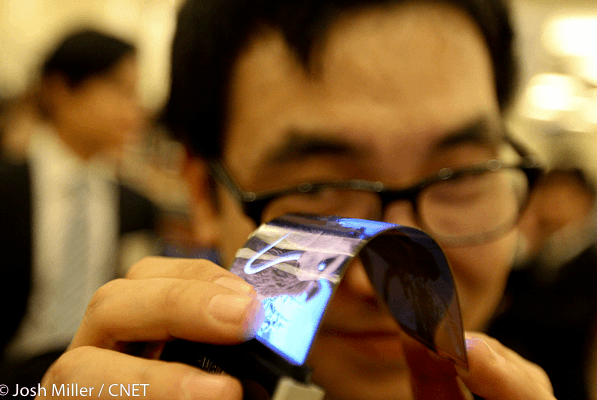Samsung is drawing closer and closer to the technology that will transform the future of smartphones and tablets.
It will show off its progress in a couple weeks at CES 2013 when it demos a 5.5-inch flexible display with a 1280×720 resolution and a 267 pixel density (an upgrade to the one pictured above from CES 2011).
While these displays are still at least a couple years away from being used in mainstream products, they represent the next big innovation in mobile devices. They will enable much thinner, more power-efficient smartphones and tablets, and a lot more flexibility (pun intended) in product designs and form factors.
The big question is whether or not Samsung would share this innovation with Apple.
As you know, Apple and Samsung are still embroiled in an epic legal battle over whether Samsung has illegally mimicked Apple devices and infringed upon Apple patents with its Galaxy family of smartphones and tablets.
Since Samsung is also the maker of lots of mobile hardware components, Apple had been one of its best customers. And from Apple’s point of view, Samsung was one of its most important partners for the iPhone, iPad, and iPod lines.
However, the legal cold war between the two companies has inevitably altered the relationship. Apple has been methodically moving business away from Samsung. While some of this has been guised in the wisdom of diversifying its supply chain, it’s impossible not to suspect this as retribution for its perceived improprieties on Samsung’s part.
Apple has significantly reduced its reliance on Samsung for memory chips. It is reportedly doing everything in its power to stop using Samsung to build the processors for its mobile devices. And it has moved much of its display business from Samsung to rival LG — although it had to reportedly go back to Samsung and use it to make the Retina display for the iPad 3 because neither LG nor Sharp could meet Apple’s next-generation display requirements.
Overall, the lost Apple business clearly hasn’t hurt Samsung too badly. It has likely used the extra capacity to supply its own Samsung Mobile business, which saw the Galaxy S3 smartphone overtake the iPhone in 2012 as the most widely sold mobile device on the planet. The Galaxy Note has been a bigger seller as well.
Meanwhile, both Apple and Samsung continued to gobble up most of the profits in the mobile device market in 2012. As they go their separate ways, both companies are doing fine. The two will almost certainly continue to dominate the mobile market in 2013, as they introduce incremental improvements to their market-leading devices.
However, it’s when we get to the next big leap forward that the divergence between Apple and Samsung could really matter.
The kind of flexible OLED displays that Samsung is showing off at CES in January are going to change the game. Because they are bendable, less breakable, lighter, thinner, and more energy-efficient, they will unleash a wave a new designs in mobile devices — lots of the things that haven’t even been imagined yet as well as designs that weren’t possible until the right technologies and materials were available.
Samsung is far and away the leader in this category. According to its own executives, Samsung produces over 90% of the OLEDs currently sold. And, it’s the only company publicly showing off these types of bendable OLEDs on a large scale — and it’s been doing it for over two years.
Read more . . .
via ZDNet – Jason Hiner
The Latest Streaming News: Samsung innovation updated minute-by-minute
Bookmark this page and come back often
Latest NEWS
Latest VIDEO








